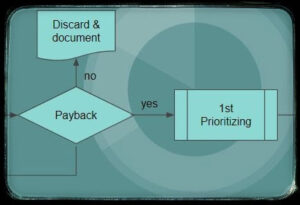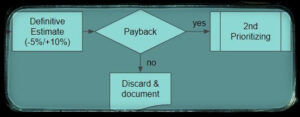Originally posted on 2018
Finding energy projects.

Finding energy projects. The first phase of the process is the generation of savings ideas through techniques such as brainstorming among energy users or between members of the technical department. Another source is the analysis of energy data establishing a baseline on which to later find deviations and analyze their causes and solve them.

Ideas generation.
In the generation of ideas phase, classical tools can be used in energy management. For example, the comparison of inefficiencies between similar equipment. Or the measurement of the current performance of an equipment to decide if the solution is a fine adjustment or a complete redesign has to be done.
Rough estimation.
From here you have to make an estimate of the savings of the project and its costs; you have to do the business case. You have to make a rough first estimate. Why? Because after the first phase may appear many ideas and many projects and a very accurate calculation of each of them would prolong the process too long. It is better to make a high level estimate, without much precision, but which allows you to prioritize afterwards a group of projects on which to execute a finer estimate. The order of magnitude of the estimate can be + 75% at least 25%.
Filtering.
After this process you have to study which payback these projects have. This will help us as one of the elements of the first prioritization. The decision process is the following. If the project does not comply with the level of payback, since it is much larger than the limit that has been established, then the idea must be discarded. But it must be documented to avoid overlapping and not to invest time in the same idea. If the project does not comply with the payback limit but is close to it, it is advisable to save it for a while and then update the business keys after a while.
Document and update after some years.
There are technologies that vary rapidly in price which may affect the costs of the project. In parallel, the benefits can also change because of a changing legislative environment. Therefore, after a reasonable period of time, such as a year, the case can be reviewed and the comparison exercise can be made against the payback.
Prioritize.
However, if you comply with the payback requirement you can move on to the next phase, which is the first priority. In addition to using the payback as an argument, you can also use other internal factors of the company, NPV, cashflow, execution time, resource intensity, strategic interests, capacity to measure the savings before and after the implementation of the project , etc.

Fine estimation.
The next phase is a fine estimate that adjusts both the calculation of the benefits and the costs with an error of at least 5% and + 10%. You can even differentiate between the different prices of the different energies. This requires a preliminary phase of capturing the performance data of the energy sources to calculate the cost of each. In addition consider all the indirect costs of generating these energies.
Second filtering.
In this repeated phase of comparison of the payback follow the same criteria. If the project complies with a good payback, it will go on to the next phase, if it is too far away, has to be discarded but documented and, if it is close, a time can be saved and the idea can be updated again.
To finish this phase comes the last prioritization, the second. In the same way that the first prioritization, use the payback, plus other internal factors of each company. Here the other variables for prioritization are much more important, such as two points availability of resources, cost of investment deadlines strategic reasons, ability to measure savings, etc.

Project management.
The following phases are typical of project management. You can use all the typical phases or group them in some general blocks. But it is advisable to emphasize the measurement and documentation of the project as well as its closure. In general, establish correctly the baseline to measure the results. Describe the necessary resources, the communication system, who are the stakeholders in this project, risks, etc.

From my experience, it is advisable to give the group members a few days or a week, to prepare the first brainstorming session. Make the results public and share them with the group for their discussion. It is also advisable to carry out several ideas generation cycles. Do this task of discovery of energy efficiency projects at the beginning of the year. And you define will be the energy objectives. Then link them to the personal objectives of the members of the group. To this part of the objectives I will dedicate a special post.
